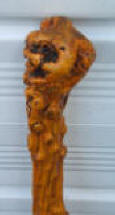
THE DIGGER' TAKES A LOOK AT THE HISTORY OF THE BLACKTHORN
'With my Shillelagh under my arm and a twinkle in my eye...
DEE, dee-dee-dee, dee deedee, dee dee-dee, dee dee-dee.....
 The opening few bars of the famous
old-time jig, "The Blackthorn Stick', one of many tunes to
which generations of folks danced the night away to in the
barns around the countryside.
The opening few bars of the famous
old-time jig, "The Blackthorn Stick', one of many tunes to
which generations of folks danced the night away to in the
barns around the countryside.
Blackthorn sticks and shillelaghs are objects that are deep-rooted in our history. There are many legends associated with the blackthorn.
One of the old proverbs tells us "With a walking stick you reach many lands - you reach many more with words."
Perhaps not the case in 1762 though. The Ulster Star supplement, published in June 1964, makes reference to 300 weavers in 1762 parading through Lisburn brandishing blackthorn sticks as a protest against the threat of unemployment. Imagine meeting that lot in Market Square!
Shillelaghs were carried in olden times as cudgels, offering the owner some form of protection against those intent on mischievous actions. They were normally made from oak or blackthorn. We are told that a County Wicklow village called Shillelagh, once a well known centre for oak production, gave its name to this world famous stick.
It would not have been uncommon in the early 19th century to see these implements used in fights and wakes around the country.
We know from the Ordnance Survey memoirs compiled in the 1830s that riots at fairs occurred locally in the village of Glenavy up to the beginning of the 19th century.
One of the leading suppliers of blackthorn sticks was H. Johnston at 31 High Street, Belfast, the umbrella and walking stick manufacturer who commenced business in 1878.
In the latter part of the 19th century a total of "one thousand five hundred dozen Irish blackthorns" were in storage on the premises. One of the local traders, James Cherry in Bow Street, Lisburn held the agency for Johnston's in the early 1900's. Bertie Boyd, 10 Market Square, Lisburn advertised walking sticks for sale in the Lisburn Standard in July 1922. They were certainly a popular commodity in those days.
In the early 1900's Theodore Roosevelt, the American President, used an old proverb when speaking to his people. "Speak softly and carry a big stick."
Edward Carson may not have spoken softly but he certainly carried a blackthorn. A poignant sight was a picture which appeared in July 1933 of Edward Carson waving his blackthorn stick in acknowledgement of the unveiling of his statute at Stormont in front of a 40,000 strong crowd. Fifteen years prior to this event Carson had been presented with a blackthorn stick by an Orange lodge at a function in Finaghy.
The Belfast Newsletter in July 1918 reported that Carson had told those present that he once had "one old blackthorn" which was with him all through the Ulster Campaign. He claimed it had been photographed at least 8,500 times. He went on to say that he had donated the blackthorn stick, which had initially been a gift from the late Lord Londonderry, for a charity auction to raise money "for the heroes who had lost their sight in the war."
It was reported to have raised £65.
Carson explained to those present that he was currently in possession of another blackthorn that had belonged to the late Lord Londonderry. It had been presented to him by Lord Londonderry's son.
On his latest presentation at Finaghy he told those present, "I can only promise you that blackthorn shall never be desecrated by any action upon my part which would have been faithless to the trust you have reposed in me."
The ripened fruit of the blackthorn, the sloe, is picked in the months of September and October and those keen sloe gin makers turn its sour taste to their advantage in the flavouring process.
You may wonder then why you may see someone stalking the hedgerows for the blackthorn during the winter period. This is the time of year when the sap is down and there is no active growth, therefore a perfect time for blackthorn stick selection and cutting by the stick maker.
Patience is a virtue in this industry. One of my old friends who resides in the district, and who started making walking sticks as a hobby almost 40 years ago, told me the sticks are left for at least a year before being worked on. Other manufacturers will leave the blackthorn in excess of five years to ensure they have been fully seasoned. My friend told me how he enjoyed Saturday afternoon rambles over the fields with his dog at his side "eyeing out" another potential stick. Many blackthorn sticks and shillelaghs have passed through his workshop over the years, ending up in places such as England, Scotland, New Zealand, Australia, France and USA.
One of his speciality sticks was a product of the whin bush or gorse as it is referred to. It is an unusual stick with many knurls and knots. One of these well-used whin sticks has spent the last 25 years or so in my family home and "is as good as the day it was made".
Its good to see that the manufacture and use of the blackthorn and similar walking sticks will be with us for some considerable time to come. Walking sticks are currently exchanging hands on the world wide web at a fantastic rate of knots these days.
Visit the Diggers new web site www.glenavyhistory.com
08/12/2006
